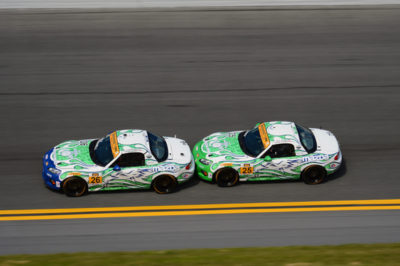You’ve built your racecar to be as aerodynamic as possible. Whether you start with an RX-7, Miata, RX-8, MX-5 or something else, you’ve got a pretty good basis and you’ve worked within the rules to make it move through the air as efficiently as it can with the help of air dams and spoilers. But if you really want to be more aerodynamic, another car would help.
No, we’re not suggesting you ditch your current racecar and buy something else. What you need is a drafting partner. Whether it’s a teammate, friend or just a competitor that you can trust, drafting will make you both faster, especially on tracks with really long straights like Road America or some of the rovals such as Daytona, Texas World Speedway or Auto Club Speedway in California.
“Two MX-5s drafting together are a lot faster than one all by itself,” explains Randy Pobst, who drives the No. 26 Freedom Autosport MX-5 in the Continental Tires SportsCar Challenge Street Tuner class with Andrew Carbonell. “At Daytona, we could get about 7mph more top speed, which is a lot. We’ll be working on that a lot – we actually practiced it with the brothers in the [No. 25 Freedom Autosport] car, Mat and Mark Pombo. In the race we ended up getting separated, though. For the sake of the manufacturers championship, we’ll also work with the CJ Wilson team cars. Drafting together is going to be an important strategy for the MX-5 teams all year long.”
On the surface, drafting seems simple enough: Get as close to the other car as possible to make the air slip over both cars as if it were one longer – and more aerodynamic – car. However, while more efficient, it can be fraught with peril.
“When you’re running so close, it’s really important not to hit your draftmate,” says Pobst. “So one strategy that works very well is to brake a little early. Don’t be one inch from his bumper in the brake zone, because it’s too easy to get tangled up. So back off a little in the brake zone, and on the exit the draft will pull you right back up on his bumper.”
He notes that while the brake zone is a very vulnerable time for cars to bump, on the straights you can get away with it, and it may even make you faster (if it’s legal under the rules of your sanctioning body). That, however – along with drafting in general – is something you will want to exercise before race time.
“Practice it, because you can’t see straight ahead very well; you have to look through the car ahead of you and pick up references from the sides,” says Pobst. “And keep one eye looking down at the water temperature gauge every so often to make sure you’re OK there, because the following car doesn’t have clean air through the radiator and on a hot day that’s a factor.”
Drafting can be a huge benefit not only in passing a competitor, but helping you and a friend or teammate catch a competitor in the first place. But a little studying of the technique before it’s time to put it into practice will go a long way toward making sure there are no mishaps on race day.


 ACCESSIBILITY
ACCESSIBILITY